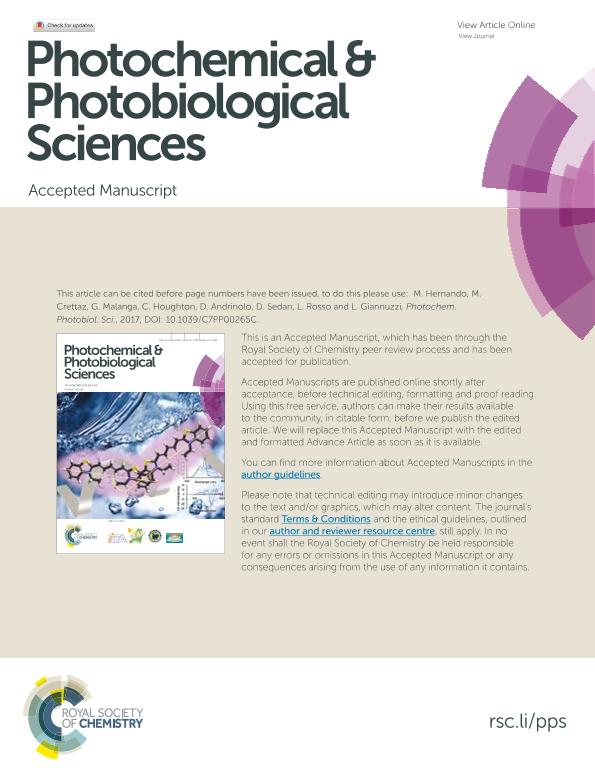Mostrar el registro sencillo del ítem
dc.contributor.author
Hernando, Marcelo Pablo

dc.contributor.author
Crettaz Minaglia, Melina Celeste

dc.contributor.author
Malanga, Gabriela Fabiana

dc.contributor.author
Houghton, Christian
dc.contributor.author
Andrinolo, Dario

dc.contributor.author
Sedan, Daniela Yazmine

dc.contributor.author
Rosso, Lorena Vanesa

dc.contributor.author
Giannuzzi, Leda

dc.date.available
2018-12-17T19:52:21Z
dc.date.issued
2017-11
dc.identifier.citation
Hernando, Marcelo Pablo; Crettaz Minaglia, Melina Celeste; Malanga, Gabriela Fabiana; Houghton, Christian; Andrinolo, Dario; et al.; Physiological responses and toxin production of Microcystis aeruginosa in short-term exposure to solar UV radiation; Royal Society of Chemistry; Photochemical and Photobiological Sciences; 17; 1; 11-2017; 69-80
dc.identifier.issn
1474-905X
dc.identifier.uri
http://hdl.handle.net/11336/66606
dc.description.abstract
The aim of this study was to evaluate the effects of short-term (hours) exposure to solar UV radiation (UVR, 280-400 nm) on the physiology of Microcystis aeruginosa. Three solar radiation treatments were implemented: (i) PAR (PAR, 400-700 nm), (ii) TUVA (PAR + UVAR, 315-700 nm) and (iii) TUVR (PAR + UVAR + UVBR, 280-700 nm). Differential responses of antioxidant enzymes and the reactive oxygen species (ROS) production to UVR were observed. Antioxidant enzymes were more active at high UVR doses. However, different responses were observed depending on the exposure to UVAR or UVBR and the dose level. No effects were observed on the biomass, ROS production or increased activity of superoxide dismutase (SOD) and catalase (CAT) compared to the control when UVR + PAR doses were lower than 9875 kJ m-2. For intermediate doses, UVR + PAR doses between 9875 and 10275 kJ m-2, oxidative stress increased while resistance was imparted through SOD and CAT in the cells exposed to UVAR. Despite the increased antioxidant activity, biomass decrease and photosynthesis inhibition were observed, but no effects were observed with added exposure to UVBR. At the highest doses (UVR + PAR higher than 10275 kJ m-2), the solar UVR caused decreased photosynthesis and biomass with only activation of CAT by UVBR and SOD and CAT by UVAR. In addition, for such doses, a significant decrease of microcystins (MCs, measured as MC-LR equivalents) was observed as a consequence of UVAR. This study facilitates our understanding of the SOD and CAT protection according to UVAR and UVBR doses and cellular damage and reinforces the importance of UVR as an environmental stressor. In addition, our results support the hypothesized antioxidant function of MCs.
dc.format
application/pdf
dc.language.iso
eng
dc.publisher
Royal Society of Chemistry

dc.rights
info:eu-repo/semantics/openAccess
dc.rights.uri
https://creativecommons.org/licenses/by-nc-sa/2.5/ar/
dc.subject
Uvr
dc.subject
Ros
dc.subject
Sod
dc.subject
Cat
dc.subject.classification
Química Orgánica

dc.subject.classification
Ciencias Químicas

dc.subject.classification
CIENCIAS NATURALES Y EXACTAS

dc.subject.classification
Otras Ciencias Químicas

dc.subject.classification
Ciencias Químicas

dc.subject.classification
CIENCIAS NATURALES Y EXACTAS

dc.title
Physiological responses and toxin production of Microcystis aeruginosa in short-term exposure to solar UV radiation
dc.type
info:eu-repo/semantics/article
dc.type
info:ar-repo/semantics/artículo
dc.type
info:eu-repo/semantics/publishedVersion
dc.date.updated
2018-10-22T19:54:37Z
dc.journal.volume
17
dc.journal.number
1
dc.journal.pagination
69-80
dc.journal.pais
Reino Unido

dc.journal.ciudad
Cambridge
dc.description.fil
Fil: Hernando, Marcelo Pablo. Comisión Nacional de Energía Atómica; Argentina
dc.description.fil
Fil: Crettaz Minaglia, Melina Celeste. Consejo Nacional de Investigaciones Científicas y Técnicas. Centro Científico Tecnológico Conicet - La Plata; Argentina. Universidad Nacional de La Plata. Facultad de Ciencias Exactas. Departamento de Ciencias Biológicas. Área de Toxicología; Argentina
dc.description.fil
Fil: Malanga, Gabriela Fabiana. Consejo Nacional de Investigaciones Científicas y Técnicas. Oficina de Coordinación Administrativa Houssay. Instituto de Bioquímica y Medicina Molecular. Universidad de Buenos Aires. Facultad Medicina. Instituto de Bioquímica y Medicina Molecular; Argentina
dc.description.fil
Fil: Houghton, Christian. Comisión Nacional de Energía Atómica; Argentina
dc.description.fil
Fil: Andrinolo, Dario. Consejo Nacional de Investigaciones Científicas y Técnicas. Centro Científico Tecnológico Conicet - La Plata; Argentina. Universidad Nacional de La Plata. Facultad de Ciencias Exactas. Departamento de Ciencias Biológicas. Área de Toxicología; Argentina
dc.description.fil
Fil: Sedan, Daniela Yazmine. Consejo Nacional de Investigaciones Científicas y Técnicas. Centro Científico Tecnológico Conicet - La Plata; Argentina. Universidad Nacional de La Plata. Facultad de Ciencias Exactas. Departamento de Ciencias Biológicas. Área de Toxicología; Argentina
dc.description.fil
Fil: Rosso, Lorena Vanesa. Consejo Nacional de Investigaciones Científicas y Técnicas. Centro Científico Tecnológico Conicet - La Plata; Argentina. Universidad Nacional de La Plata. Facultad de Ciencias Exactas. Departamento de Ciencias Biológicas. Área de Toxicología; Argentina
dc.description.fil
Fil: Giannuzzi, Leda. Consejo Nacional de Investigaciones Científicas y Técnicas. Centro Científico Tecnológico Conicet - La Plata; Argentina. Universidad Nacional de La Plata. Facultad de Ciencias Exactas. Departamento de Ciencias Biológicas. Área de Toxicología; Argentina
dc.journal.title
Photochemical and Photobiological Sciences

dc.relation.alternativeid
info:eu-repo/semantics/altIdentifier/url/https://pubs.rsc.org/en/Content/ArticleLanding/2018/PP/C7PP00265C#!divAbstract
dc.relation.alternativeid
info:eu-repo/semantics/altIdentifier/doi/http://dx.doi.org/10.1039/C7PP00265C
Archivos asociados
